NIMA Gluten Sensor and a Grand Halloween Mistake
As an Amazon Associate and member of other affiliate programs, I earn from qualifying purchases.
Scared by the presence of unknown gluten? While devices like the NIMA sensor sound fantastic, this testing system has limitations. For example, NIMA sensors can not accurately test barley malt, In 2017, this lead to a Grand mistake on social media.

A Very Scary Halloween
Halloween. When you live with a food allergy or food sensitivity, what frightens you more than costumes is candy. Does the candy in question contain your allergen? Did manufacturers produce this sweet on a shared line with an allergen? Does this candy contain undeclared gluten, which is found in wheat, barley, malt, and rye? What recently scares me most is faulty info based on the NIMA gluten sensor.
Halloween was unique for me in 2017. My husband and I drove a 20 foot Uhaul from Michigan to South Dakota, with our car in tow. (Confession – He drove. I “navigated.”) We chose to spend our vacation helping our friends move all their belongings 800+ miles away, due to a new job. No costumes for us. No decorated van passing out safe treats from our Teal Pumpkin Project – inspired stash of goodies. Therefore, I vicariously enjoyed Halloween through social media. From the comfort of the Uhaul (oxymoron?), I perused Instagram.
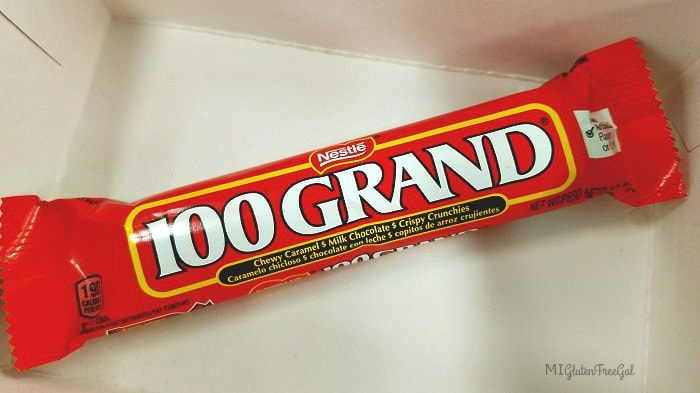
What is a NIMA Partners Gluten Sensor?
We were somewhere in the plains of Minnesota, between Rochester and Sioux Falls, when I noticed an Instagram post of a 100 Grand candy bar. What’s a 100 Grand Bar? Imagine a Nestle Crunch with a caramel layer inside. The post showed a 100 Grand being tested with a NIMA.
What’s NIMA? It’s a portable electronic device that tests for gluten in food. How does it do this? In simple terms, you put in a pea-sized amount of the food you want to test in a capsule. The capsule contains a solution and you place the capsule in the triangular device, and it uses testing methods to detect the presence of gluten.
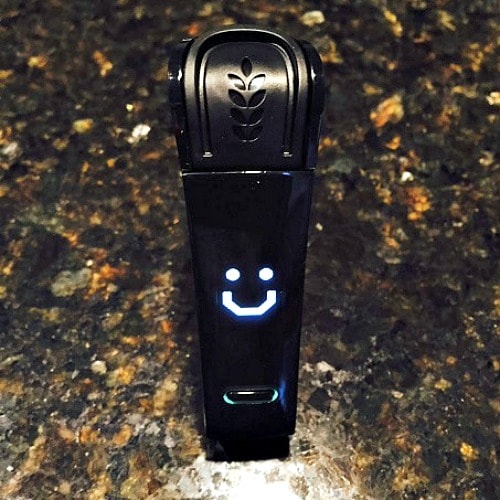
Not Everything You See Online is Accurate
So, what caught my eye was that results on the NIMA. The Instagram post showed a NIMA with a smiley face. This in theory means that the product is safe to eat. The person posting only had the small miniature 100 Grand Bar, but not the larger bag from which it came. While we plodded along I-90, I did a Google search for a 100 Grand Bar.
I was concerned because all the sites I saw (including Amazon) stated that the bar contained crisped rice, which are made with “rice flour, sugar, BARLEY MALT, and salt.” For those that may not know, barley malt contains gluten. Therefore, the device should NOT have resulted in a “smiley face.”
I wondered “Did Nestle change their recipe?” My husband, who is completely a saint, agreed to pull off the freeway in Fairmont, Minnesota and let me stop at a grocery store to check. So I wandered into the store, and asked one of the incredibly helpful staff to help me locate one of these 100 Grand bars. Here’s what I found.
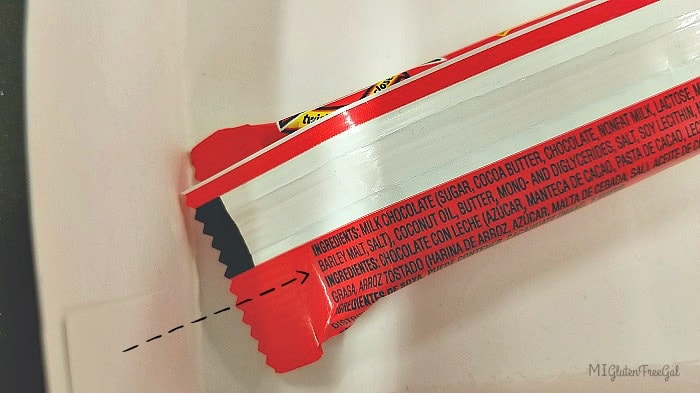
Nestle 100 Grand Bars Contain Barley Malt
Yep, barley malt. So I private messaged the owner of the Instagram account that posted the NIMA result. I shared this information. They updated their comments on their account, their blog post, and ultimately removed the image. (Why remove it? People were solely looking at the image of the “smiley faced NIMA” with the candy in question, and not the warning.)
But the question remained. How did this happen? Like any other technology, there can be limitations of use. Below is how NIMA responded (in 2017) as to how this could happen. (Names of other Twitter users blocked out to protect privacy.)
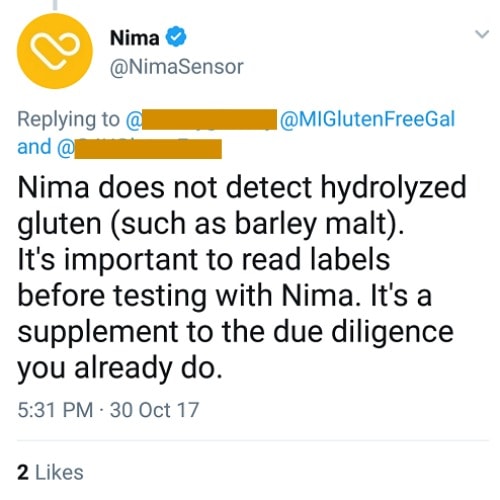
NIMA Sensors Cannot Test for the Presence of Barley Malt
So, there’s our answer. NIMA does not detect barley malt. So in theory, Kellogg’s Rice Krispies will come back with a smiley face. This also means something with hydrolyzed wheat, such as soy sauce, could come back as being “safe.” This is something that definitely doesn’t bring a smile to MY face.
What Other Limitations Do NIMA Testing Devices Have?
After a quick visit to the NIMA Partners website, their “gluten manual” states the following limitations
“NIMA Partners has not been validated on medication, cosmetics or non food items.” Therefore, be wary if you see an Instagram influencer use their NIMA to test medications, whether prescription or over the counter. Other NIMA limitations include:
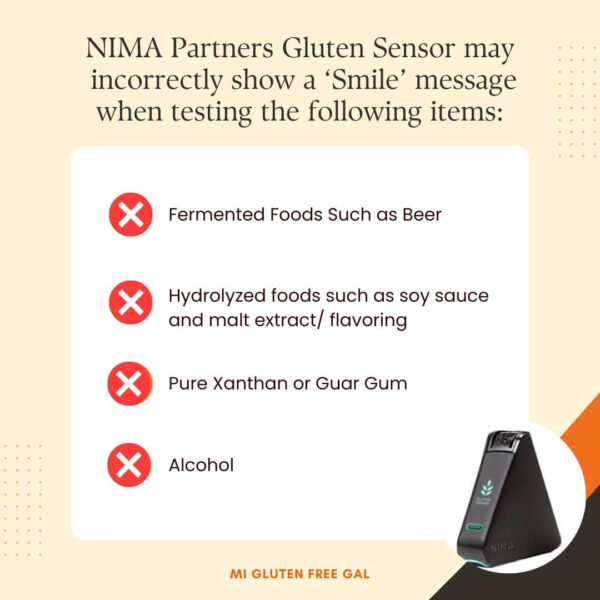
Other Red Flags
In addition, their manual gives additional advice on how to test foods that are thick/ dense, dry/ powdery, and brightly colored. Foods in these categories may return inaccurate results. “Bright foods can interfere with the sensor’s ability to read the result. These foods should also be mixed with water to dilute the coloring.” This includes red foods, such as pizza sauce or marinara.
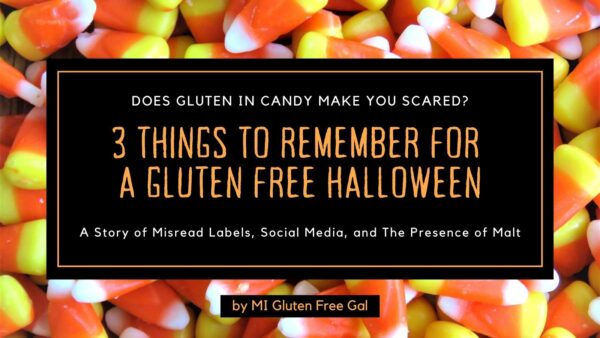
Three Things to Remember
1. Ingredient Lists Aren’t Required on Mini Candy Bars
Here’s where the Instagram account that posted the original picture faltered. That person ONLY had one of the 100 Grand miniature candy bars. He / she did not have the larger bag from whence it came, nor did the mini candy bar have a complete ingredient list.
Mini bars, especially those passed out on holidays such has Halloween, do not always have a complete list of ingredients on the wrapper. If you question a food item, and the ingredients are not on the packaging, try to look it up online. ALSO – make sure to read comments on posts as well. Pictures and ratings can be deceptive.
2. Barley & Rye are Not Allergens Under FALCPA
The person who originally posted the image went by the “allergen warning” on the wrapper. The wrapper did not list barley as a potential allergen. Here’s the thing though. It doesn’t have to. Barley, as well as rye, are not one of the Top 9 allergens that must be declared under the FALCPA guidelines. (FALCPA = Food Allergen Labeling and Consumer Protection Act) The Top 9 include wheat, fish, shellfish, eggs, dairy, peanuts, tree nuts, soy and sesame. The person that originally posted the 100 Grand bar on Instagram relied on the fact that the allergen warning did NOT list wheat. They falsely concluded it therefore must be free of gluten.
3. You are Smarter Than Technology
NIMA is a tool one can use to help make decisions about what we eat. However, it is nothing more than that. NIMA is not without its limitations. Results can have errors because a sample is too small, too large, or even because it is red. From above we can see that it can declare a food as “safe” when it is not. Cases have also shown that products can result in an “frown” even when a product is actually gluten-free. Read my thoughts on a restaurant study performed via NIMA testing, for more info.
My Final Thoughts About the NIMA Partners Gluten Sensor
So here is where I voice my opinion. NIMA has become a controversial issue in the Celiac Disease community. I try not to share my own opinion about the NIMA too often. Instead I attempt to share facts of how how it performs, and allow you to make your own educated decision. However, based on that evidence, I am not a fan of the device. I fear it leads to more anxiety about eating gluten free, not less.
Safe Gluten Free Halloween Candy
Many sites exist that offer gluten free Halloween Candy lists. A few examples include-
- Celiac Mama’s Gluten Free Halloween Candy List (updated Sept 2022)
- GF Jules Gluten Free Halloween Candy List
- Beyond Celiac Gluten Free Halloween Candy List
Do you own a NIMA? What do test with it? What holiday candies do you trust to be gluten-free?

So my young kids have Celiac. They’ve been successfuly gluten free (except when they glutened that one time at school) for 1.5 years, at no small effort to me. I pour over articles, wait on hold for 20 minutes stretches and and read the blogs. I google everything.
This Halloween I glutened my girls with the 100Grand bar. I had seen it on 2 safe lists prior to trick or treating. The funsize candy has no listing of ingredients, just allergen warning. I KNOW about barley malt in crispies. And yet… I saw it online and thought it was safe. They got like 10 of these for some reason this Halloween, probably due to the Costco mixed bag that has it. They tried it and LOVED it. Then proceeded to eat that candy only as dessert and treat for the next 2 days. Then I noticed some bloating and unusual has from the more sensitive twin. I immediately called Nestle for an answer and discovered I had Glutened them. Nestle could really do us all a favor and PUT the Darn ingredients on the candy! Others do, it’s not that hard.
—my kids are fine. They got some skin rash, not painful and the gas- no headache or diahrrea. But I’m still mad at Nestlé, myself, and illness in general. Thanks for this post.
Dear Jacquie,
Thank you so much for reading and for commenting. Your story is so important for so many reasons.
1) Even the most careful of us still manage to get gluten in our diet. It happens, and we all need to give ourselves and each other grace. Please extend yourself some grace.
2) Companies need to do better with packaging. Glad that Nestle finally gave you answers, albeit after the fact. Milky Way minis also contain barley malt, and I’d be curious if it lists that on the minis. (The Midnight & Just Caramel do not contain gluten ingredients.)
3) It reminds bloggers like me that we need to do thorough investigation before printing anything. The person who originally posted the picture is a blogger, who compiled a “safe candy list,” and included the 100 Grand on the list based on the NIMA results. That blogger quickly corrected him/herself and notified his/her followers. But sometimes the damage had been done at that point.
I truly appreciate your comments. If it’s okay, I’d like to share your story on my FB page. And as always, please feel free to reach out any time.
Sincerely,
Margaret
Hi Margaret! Thanks so much for this write up. I feel the same way about the Nima. I’m so excited that advances Luke this ate being developed, but I’m not comfortable with its performance to trust my health to it. I’ve learned that it also does not detect fermented gluten, which means soy sauce and beer. As a community, we need to continue to advocate for clear labeling and safe production practices. Thanks for your voice!
Dear Julie,
Thanks so much for your comment! I was so excited when NIMA came out. I think it has promise if they can fox some issues. Unfortunately it was not verified by outside parties before it was released, and has caused more headaches than happiness. Here’s hoping they can get the kinks worked out!
I think it’s best to assume anything made with crisped rice contains barley malt unless it states it’s made from certified gf crispy rice. I’ve been at this diet for 30 years, (about to start my 31 year) and the candy bars in question have always contained barley malt. It’s in both the fun sized and the full sized.
When I was diagnosed way back in the 80s, rice krispies were fed to me in the hospital. I asked the dietitian about it and she said they were aware of the malt but they continued to use them on their celiac patients because they were well tolerated by the majority of celiacs. That fact was noted in all of the paperwork I was given from the hospital. Mind you, I was majorly sick when I got diagnosed. I was hospitalized for around 2 weeks. In spite of eating the rice krispies, I still healed slowly but surely. These days I don’t eat much cereal, but at the time I was starving and the rice krispies actually didn’t hurt to eat. Most foods caused so much pain my poor belly, I had totally stopped being able to eat anything for a good month before my diagnosis.
I’m not telling anyone it’s ok to eat cereals with barley malt syrup. Just want people to know if they make a mistake and and accidentally injest it, it’s probably the least potent form of gluten to mess up on.
Thanks for reading and commenting. Glad to know that you are feeling so much better!
I will have to disagree though that it is the “least potent form.” Celiac has over 300 associated symptoms, and people react to different grains differently. We must all be vigilant and medical professionals need to do better.
I have no problem with your disagreement Margaret. That was a very long time ago and you see I do know what does contain barley mslt. I avoid it avoided encourage all my fellow celiacs to avoided void it too